Classification apparatus, classification method, and program
a technology of classification apparatus and classification method, applied in the field of classification apparatus, a classification method, and a program, can solve problems such as complicated light pattern, and achieve the effect of reducing time and cos
- Summary
- Abstract
- Description
- Claims
- Application Information
AI Technical Summary
Benefits of technology
Problems solved by technology
Method used
Image
Examples
first embodiment
[0036]A first embodiment will be described with reference to the drawings.
Overview
[0037]In a first embodiment, machine learning is performed based on measurement information obtained by a sensor, and the state of a predetermined space is detected using a detection function that has learned through the machine learning.
[0038]FIG. 1 is a diagram illustrating an overview of a classification system according to a first embodiment. As shown in FIG. 1, the classification system according to a first embodiment first creates learning data using a learning data creation system 1 (1). The learning data creation system 1 creates training data (learning data) based on measurement information indicating a detection target obtained by the sensor, and information indicating the state of a predetermined space.
[0039]Next, a learning service system 2 performs supervised learning with a neural network, based on the learning data created by the learning data creation system 1 (2). The learning service ...
operation example
[0094]FIG. 6 illustrates an operation example of the learning environment preparation apparatus 11 according to a first embodiment. The learning environment preparation apparatus 11 is an apparatus for creating learning data, which is training data, as mentioned above.
[0095]The light projection unit 111 projects light, such as infrared light (S101). The light projection information acquisition unit 112 then collects the light projection pattern of the light, such as infrared light, projected by the light projection unit 111 (S102).
[0096]The light receiving unit 113 receives the light from the light projection unit (S103), and outputs the received light to the detection unit 115 (S104).
[0097]The detection unit 115 detects the light reception pattern of the light input from the light receiving unit 113 (S105).
[0098]The spatial state information input unit 114 receives input of information indicating the position and / or the state of a person, an object, a robot, or the like, which is a...
second embodiment
[0197]A second embodiment will be described with reference to the drawings.
[0198]A second embodiment is one or more embodiments in the case of using an auxiliary sensor, in addition to the above-described sensor, to create learning data and detect the state where a target is present. The ability to detect the state of a predetermined space can be further enhanced by using various auxiliary sensors in addition to the sensor for projecting and receiving light such as infrared light.
[0199]FIG. 12 is a diagram illustrating a configuration example of the learning environment preparation apparatus 11 according to a second embodiment. As shown in FIG. 12, the learning environment preparation apparatus 11 includes an auxiliary sensor 117.
[0200]FIG. 13 is a diagram illustrating a configuration example of the spatial state detection apparatus 4 according to a second embodiment. As shown in FIG. 13, the spatial state detection apparatus 4 includes an auxiliary sensor 46.
Auxiliary Sensor
[0201]T...
PUM
 Login to View More
Login to View More Abstract
Description
Claims
Application Information
 Login to View More
Login to View More - R&D
- Intellectual Property
- Life Sciences
- Materials
- Tech Scout
- Unparalleled Data Quality
- Higher Quality Content
- 60% Fewer Hallucinations
Browse by: Latest US Patents, China's latest patents, Technical Efficacy Thesaurus, Application Domain, Technology Topic, Popular Technical Reports.
© 2025 PatSnap. All rights reserved.Legal|Privacy policy|Modern Slavery Act Transparency Statement|Sitemap|About US| Contact US: help@patsnap.com



